Bilateral relationship between Australia and Japan
VerifiedAdded on 2023/06/05
|6
|1399
|196
AI Summary
The essay elaborates on the main features of the bilateral relationship between Australia and Japan while evaluating its significance in the present days. The features include strategic partnership, economic engagement, and cultural relationship. The study concludes that the bilateral relationship is still significant in the present days.
Contribute Materials
Your contribution can guide someone’s learning journey. Share your
documents today.

Running head: Bilateral relationship between Australia and Japan
Bilateral relationship between Australia and Japan
Name of the student
Name of the University
Author note
Bilateral relationship between Australia and Japan
Name of the student
Name of the University
Author note
Secure Best Marks with AI Grader
Need help grading? Try our AI Grader for instant feedback on your assignments.
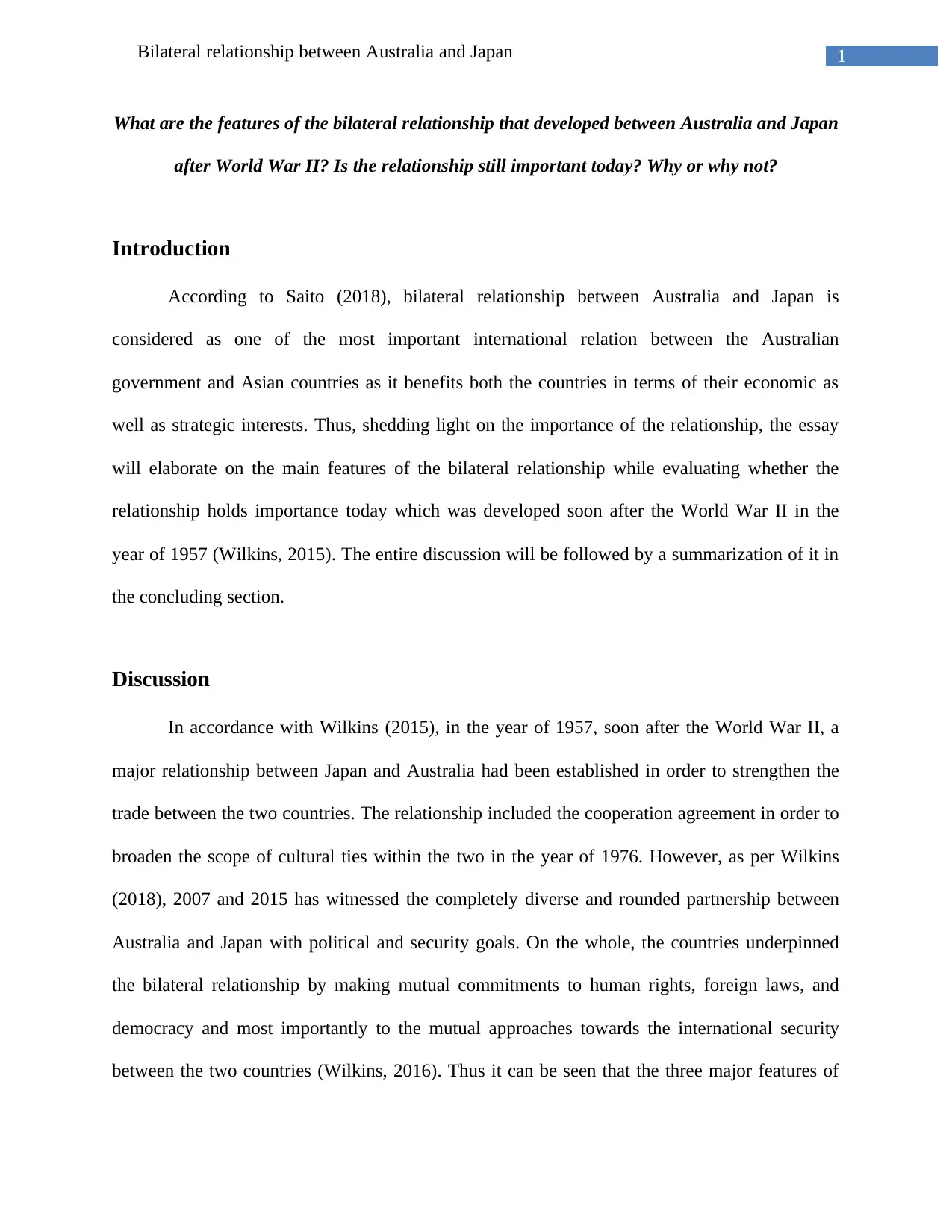
1Bilateral relationship between Australia and Japan
What are the features of the bilateral relationship that developed between Australia and Japan
after World War II? Is the relationship still important today? Why or why not?
Introduction
According to Saito (2018), bilateral relationship between Australia and Japan is
considered as one of the most important international relation between the Australian
government and Asian countries as it benefits both the countries in terms of their economic as
well as strategic interests. Thus, shedding light on the importance of the relationship, the essay
will elaborate on the main features of the bilateral relationship while evaluating whether the
relationship holds importance today which was developed soon after the World War II in the
year of 1957 (Wilkins, 2015). The entire discussion will be followed by a summarization of it in
the concluding section.
Discussion
In accordance with Wilkins (2015), in the year of 1957, soon after the World War II, a
major relationship between Japan and Australia had been established in order to strengthen the
trade between the two countries. The relationship included the cooperation agreement in order to
broaden the scope of cultural ties within the two in the year of 1976. However, as per Wilkins
(2018), 2007 and 2015 has witnessed the completely diverse and rounded partnership between
Australia and Japan with political and security goals. On the whole, the countries underpinned
the bilateral relationship by making mutual commitments to human rights, foreign laws, and
democracy and most importantly to the mutual approaches towards the international security
between the two countries (Wilkins, 2016). Thus it can be seen that the three major features of
What are the features of the bilateral relationship that developed between Australia and Japan
after World War II? Is the relationship still important today? Why or why not?
Introduction
According to Saito (2018), bilateral relationship between Australia and Japan is
considered as one of the most important international relation between the Australian
government and Asian countries as it benefits both the countries in terms of their economic as
well as strategic interests. Thus, shedding light on the importance of the relationship, the essay
will elaborate on the main features of the bilateral relationship while evaluating whether the
relationship holds importance today which was developed soon after the World War II in the
year of 1957 (Wilkins, 2015). The entire discussion will be followed by a summarization of it in
the concluding section.
Discussion
In accordance with Wilkins (2015), in the year of 1957, soon after the World War II, a
major relationship between Japan and Australia had been established in order to strengthen the
trade between the two countries. The relationship included the cooperation agreement in order to
broaden the scope of cultural ties within the two in the year of 1976. However, as per Wilkins
(2018), 2007 and 2015 has witnessed the completely diverse and rounded partnership between
Australia and Japan with political and security goals. On the whole, the countries underpinned
the bilateral relationship by making mutual commitments to human rights, foreign laws, and
democracy and most importantly to the mutual approaches towards the international security
between the two countries (Wilkins, 2016). Thus it can be seen that the three major features of
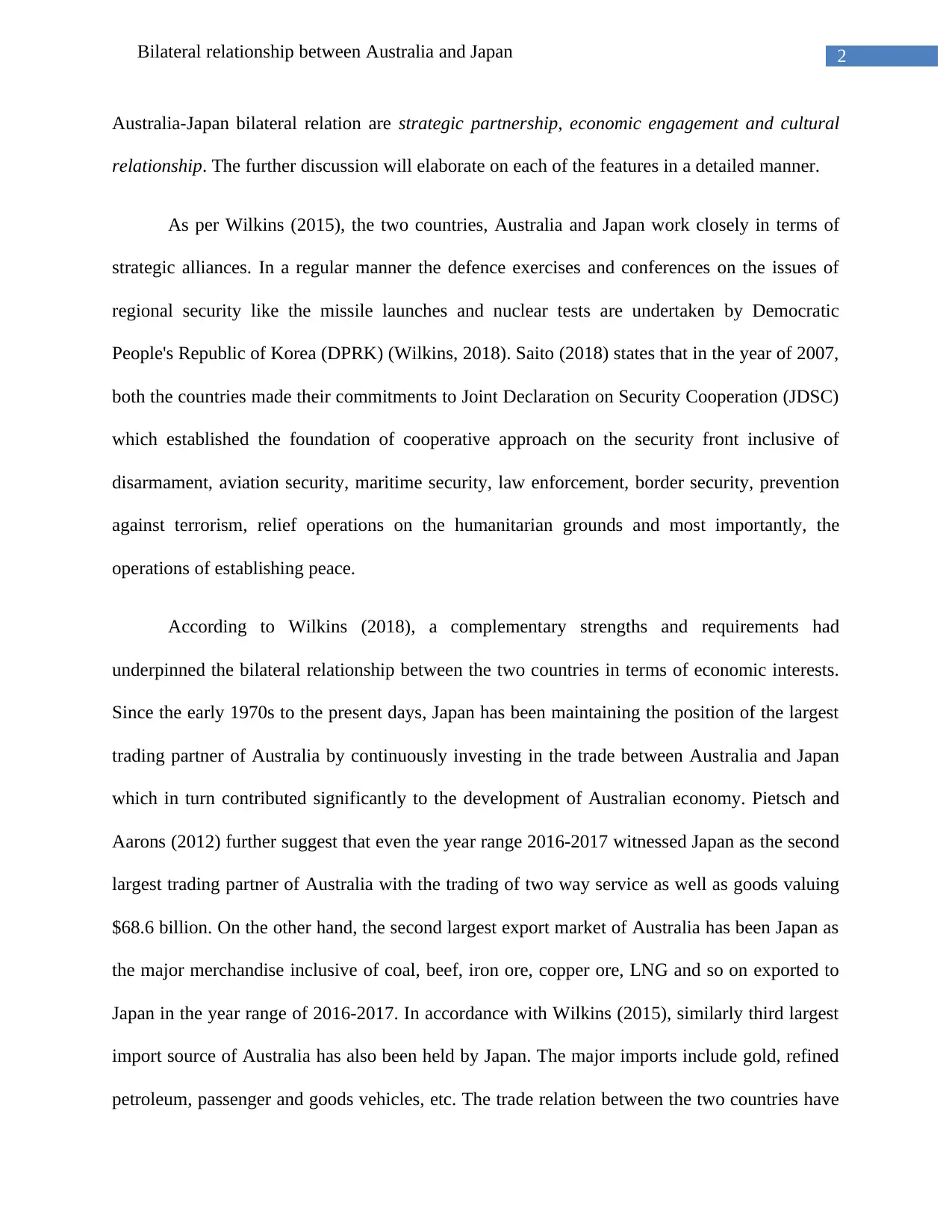
2Bilateral relationship between Australia and Japan
Australia-Japan bilateral relation are strategic partnership, economic engagement and cultural
relationship. The further discussion will elaborate on each of the features in a detailed manner.
As per Wilkins (2015), the two countries, Australia and Japan work closely in terms of
strategic alliances. In a regular manner the defence exercises and conferences on the issues of
regional security like the missile launches and nuclear tests are undertaken by Democratic
People's Republic of Korea (DPRK) (Wilkins, 2018). Saito (2018) states that in the year of 2007,
both the countries made their commitments to Joint Declaration on Security Cooperation (JDSC)
which established the foundation of cooperative approach on the security front inclusive of
disarmament, aviation security, maritime security, law enforcement, border security, prevention
against terrorism, relief operations on the humanitarian grounds and most importantly, the
operations of establishing peace.
According to Wilkins (2018), a complementary strengths and requirements had
underpinned the bilateral relationship between the two countries in terms of economic interests.
Since the early 1970s to the present days, Japan has been maintaining the position of the largest
trading partner of Australia by continuously investing in the trade between Australia and Japan
which in turn contributed significantly to the development of Australian economy. Pietsch and
Aarons (2012) further suggest that even the year range 2016-2017 witnessed Japan as the second
largest trading partner of Australia with the trading of two way service as well as goods valuing
$68.6 billion. On the other hand, the second largest export market of Australia has been Japan as
the major merchandise inclusive of coal, beef, iron ore, copper ore, LNG and so on exported to
Japan in the year range of 2016-2017. In accordance with Wilkins (2015), similarly third largest
import source of Australia has also been held by Japan. The major imports include gold, refined
petroleum, passenger and goods vehicles, etc. The trade relation between the two countries have
Australia-Japan bilateral relation are strategic partnership, economic engagement and cultural
relationship. The further discussion will elaborate on each of the features in a detailed manner.
As per Wilkins (2015), the two countries, Australia and Japan work closely in terms of
strategic alliances. In a regular manner the defence exercises and conferences on the issues of
regional security like the missile launches and nuclear tests are undertaken by Democratic
People's Republic of Korea (DPRK) (Wilkins, 2018). Saito (2018) states that in the year of 2007,
both the countries made their commitments to Joint Declaration on Security Cooperation (JDSC)
which established the foundation of cooperative approach on the security front inclusive of
disarmament, aviation security, maritime security, law enforcement, border security, prevention
against terrorism, relief operations on the humanitarian grounds and most importantly, the
operations of establishing peace.
According to Wilkins (2018), a complementary strengths and requirements had
underpinned the bilateral relationship between the two countries in terms of economic interests.
Since the early 1970s to the present days, Japan has been maintaining the position of the largest
trading partner of Australia by continuously investing in the trade between Australia and Japan
which in turn contributed significantly to the development of Australian economy. Pietsch and
Aarons (2012) further suggest that even the year range 2016-2017 witnessed Japan as the second
largest trading partner of Australia with the trading of two way service as well as goods valuing
$68.6 billion. On the other hand, the second largest export market of Australia has been Japan as
the major merchandise inclusive of coal, beef, iron ore, copper ore, LNG and so on exported to
Japan in the year range of 2016-2017. In accordance with Wilkins (2015), similarly third largest
import source of Australia has also been held by Japan. The major imports include gold, refined
petroleum, passenger and goods vehicles, etc. The trade relation between the two countries have
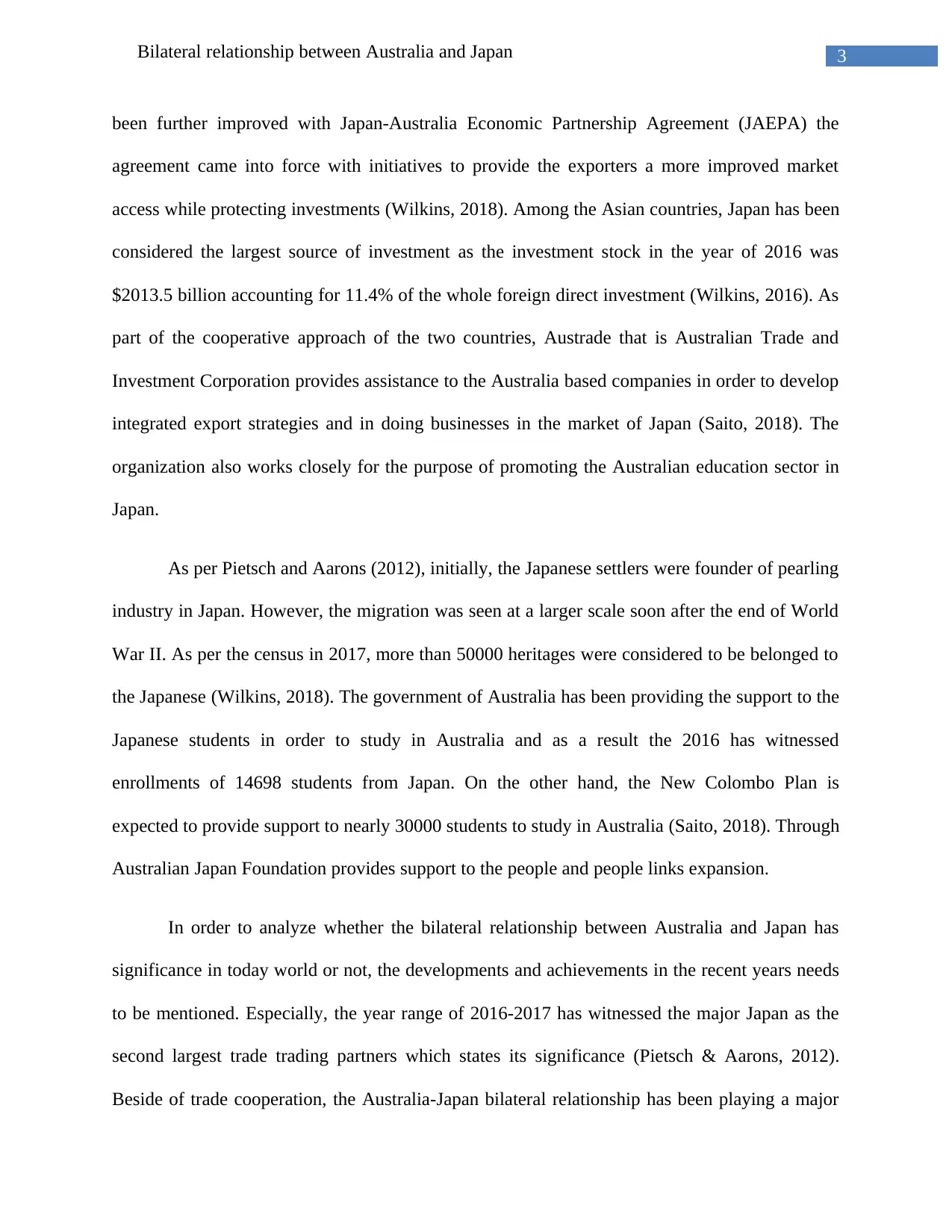
3Bilateral relationship between Australia and Japan
been further improved with Japan-Australia Economic Partnership Agreement (JAEPA) the
agreement came into force with initiatives to provide the exporters a more improved market
access while protecting investments (Wilkins, 2018). Among the Asian countries, Japan has been
considered the largest source of investment as the investment stock in the year of 2016 was
$2013.5 billion accounting for 11.4% of the whole foreign direct investment (Wilkins, 2016). As
part of the cooperative approach of the two countries, Austrade that is Australian Trade and
Investment Corporation provides assistance to the Australia based companies in order to develop
integrated export strategies and in doing businesses in the market of Japan (Saito, 2018). The
organization also works closely for the purpose of promoting the Australian education sector in
Japan.
As per Pietsch and Aarons (2012), initially, the Japanese settlers were founder of pearling
industry in Japan. However, the migration was seen at a larger scale soon after the end of World
War II. As per the census in 2017, more than 50000 heritages were considered to be belonged to
the Japanese (Wilkins, 2018). The government of Australia has been providing the support to the
Japanese students in order to study in Australia and as a result the 2016 has witnessed
enrollments of 14698 students from Japan. On the other hand, the New Colombo Plan is
expected to provide support to nearly 30000 students to study in Australia (Saito, 2018). Through
Australian Japan Foundation provides support to the people and people links expansion.
In order to analyze whether the bilateral relationship between Australia and Japan has
significance in today world or not, the developments and achievements in the recent years needs
to be mentioned. Especially, the year range of 2016-2017 has witnessed the major Japan as the
second largest trade trading partners which states its significance (Pietsch & Aarons, 2012).
Beside of trade cooperation, the Australia-Japan bilateral relationship has been playing a major
been further improved with Japan-Australia Economic Partnership Agreement (JAEPA) the
agreement came into force with initiatives to provide the exporters a more improved market
access while protecting investments (Wilkins, 2018). Among the Asian countries, Japan has been
considered the largest source of investment as the investment stock in the year of 2016 was
$2013.5 billion accounting for 11.4% of the whole foreign direct investment (Wilkins, 2016). As
part of the cooperative approach of the two countries, Austrade that is Australian Trade and
Investment Corporation provides assistance to the Australia based companies in order to develop
integrated export strategies and in doing businesses in the market of Japan (Saito, 2018). The
organization also works closely for the purpose of promoting the Australian education sector in
Japan.
As per Pietsch and Aarons (2012), initially, the Japanese settlers were founder of pearling
industry in Japan. However, the migration was seen at a larger scale soon after the end of World
War II. As per the census in 2017, more than 50000 heritages were considered to be belonged to
the Japanese (Wilkins, 2018). The government of Australia has been providing the support to the
Japanese students in order to study in Australia and as a result the 2016 has witnessed
enrollments of 14698 students from Japan. On the other hand, the New Colombo Plan is
expected to provide support to nearly 30000 students to study in Australia (Saito, 2018). Through
Australian Japan Foundation provides support to the people and people links expansion.
In order to analyze whether the bilateral relationship between Australia and Japan has
significance in today world or not, the developments and achievements in the recent years needs
to be mentioned. Especially, the year range of 2016-2017 has witnessed the major Japan as the
second largest trade trading partners which states its significance (Pietsch & Aarons, 2012).
Beside of trade cooperation, the Australia-Japan bilateral relationship has been playing a major
Secure Best Marks with AI Grader
Need help grading? Try our AI Grader for instant feedback on your assignments.
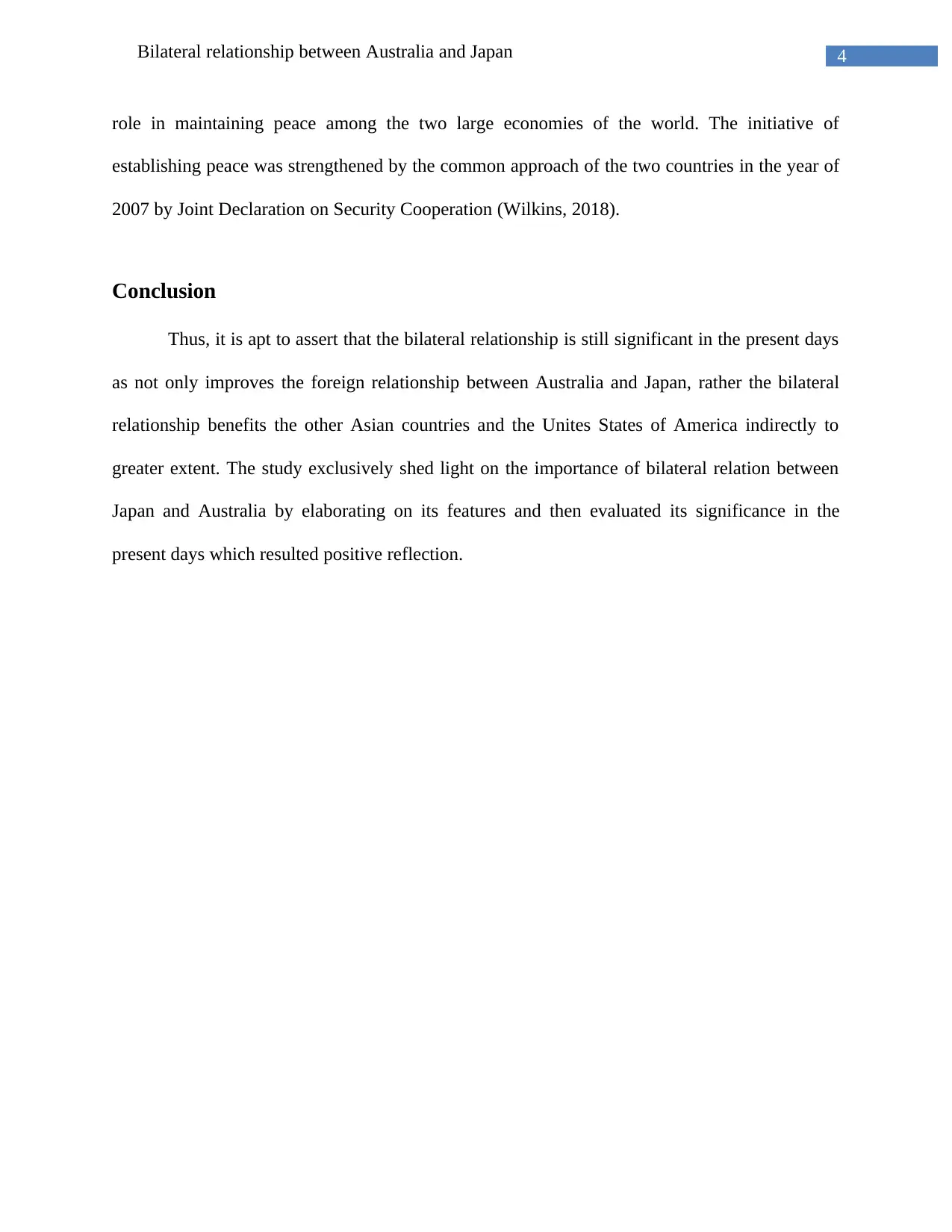
4Bilateral relationship between Australia and Japan
role in maintaining peace among the two large economies of the world. The initiative of
establishing peace was strengthened by the common approach of the two countries in the year of
2007 by Joint Declaration on Security Cooperation (Wilkins, 2018).
Conclusion
Thus, it is apt to assert that the bilateral relationship is still significant in the present days
as not only improves the foreign relationship between Australia and Japan, rather the bilateral
relationship benefits the other Asian countries and the Unites States of America indirectly to
greater extent. The study exclusively shed light on the importance of bilateral relation between
Japan and Australia by elaborating on its features and then evaluated its significance in the
present days which resulted positive reflection.
role in maintaining peace among the two large economies of the world. The initiative of
establishing peace was strengthened by the common approach of the two countries in the year of
2007 by Joint Declaration on Security Cooperation (Wilkins, 2018).
Conclusion
Thus, it is apt to assert that the bilateral relationship is still significant in the present days
as not only improves the foreign relationship between Australia and Japan, rather the bilateral
relationship benefits the other Asian countries and the Unites States of America indirectly to
greater extent. The study exclusively shed light on the importance of bilateral relation between
Japan and Australia by elaborating on its features and then evaluated its significance in the
present days which resulted positive reflection.
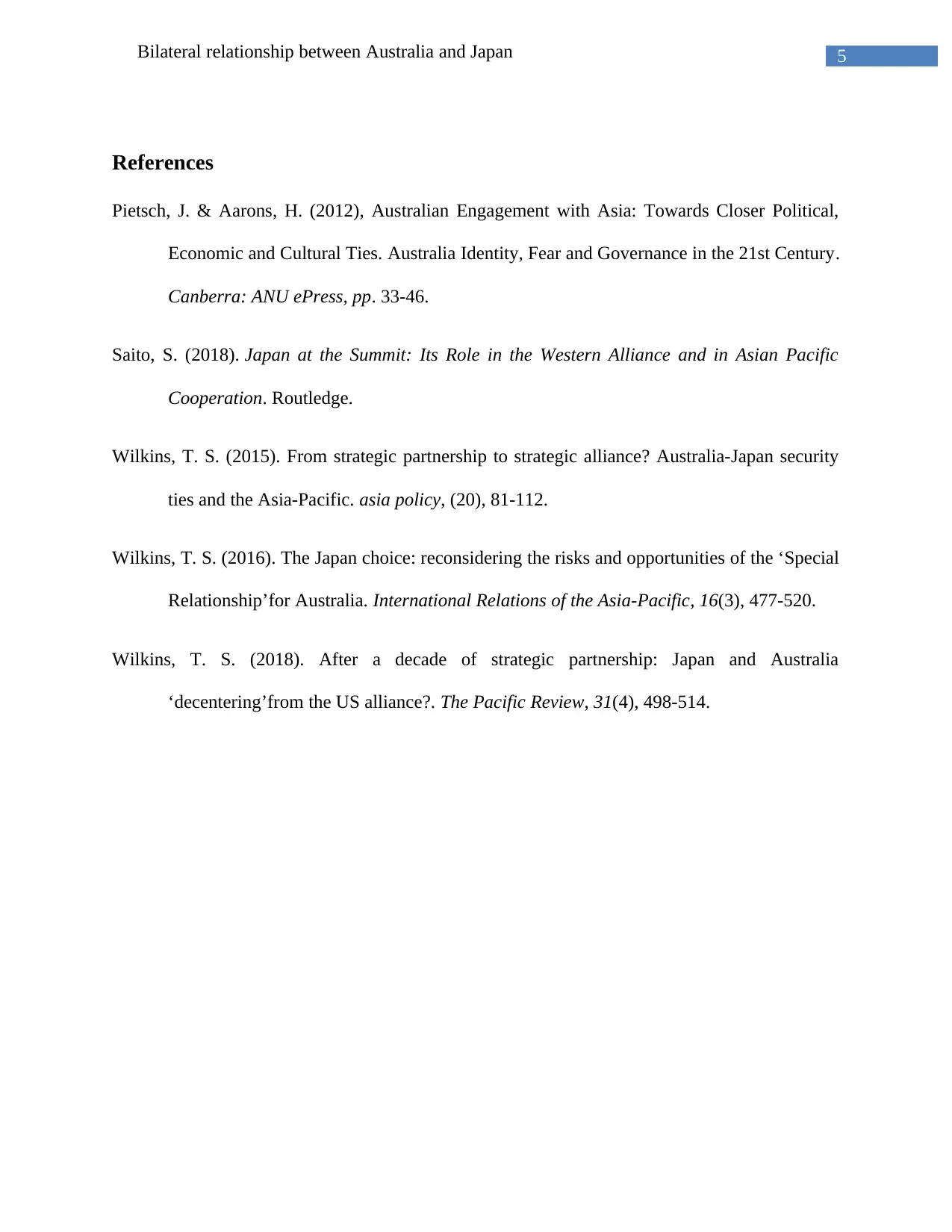
5Bilateral relationship between Australia and Japan
References
Pietsch, J. & Aarons, H. (2012), Australian Engagement with Asia: Towards Closer Political,
Economic and Cultural Ties. Australia Identity, Fear and Governance in the 21st Century.
Canberra: ANU ePress, pp. 33-46.
Saito, S. (2018). Japan at the Summit: Its Role in the Western Alliance and in Asian Pacific
Cooperation. Routledge.
Wilkins, T. S. (2015). From strategic partnership to strategic alliance? Australia-Japan security
ties and the Asia-Pacific. asia policy, (20), 81-112.
Wilkins, T. S. (2016). The Japan choice: reconsidering the risks and opportunities of the ‘Special
Relationship’for Australia. International Relations of the Asia-Pacific, 16(3), 477-520.
Wilkins, T. S. (2018). After a decade of strategic partnership: Japan and Australia
‘decentering’from the US alliance?. The Pacific Review, 31(4), 498-514.
References
Pietsch, J. & Aarons, H. (2012), Australian Engagement with Asia: Towards Closer Political,
Economic and Cultural Ties. Australia Identity, Fear and Governance in the 21st Century.
Canberra: ANU ePress, pp. 33-46.
Saito, S. (2018). Japan at the Summit: Its Role in the Western Alliance and in Asian Pacific
Cooperation. Routledge.
Wilkins, T. S. (2015). From strategic partnership to strategic alliance? Australia-Japan security
ties and the Asia-Pacific. asia policy, (20), 81-112.
Wilkins, T. S. (2016). The Japan choice: reconsidering the risks and opportunities of the ‘Special
Relationship’for Australia. International Relations of the Asia-Pacific, 16(3), 477-520.
Wilkins, T. S. (2018). After a decade of strategic partnership: Japan and Australia
‘decentering’from the US alliance?. The Pacific Review, 31(4), 498-514.
1 out of 6
Related Documents
Your All-in-One AI-Powered Toolkit for Academic Success.
+13062052269
info@desklib.com
Available 24*7 on WhatsApp / Email
![[object Object]](/_next/static/media/star-bottom.7253800d.svg)
Unlock your academic potential
© 2024 | Zucol Services PVT LTD | All rights reserved.


